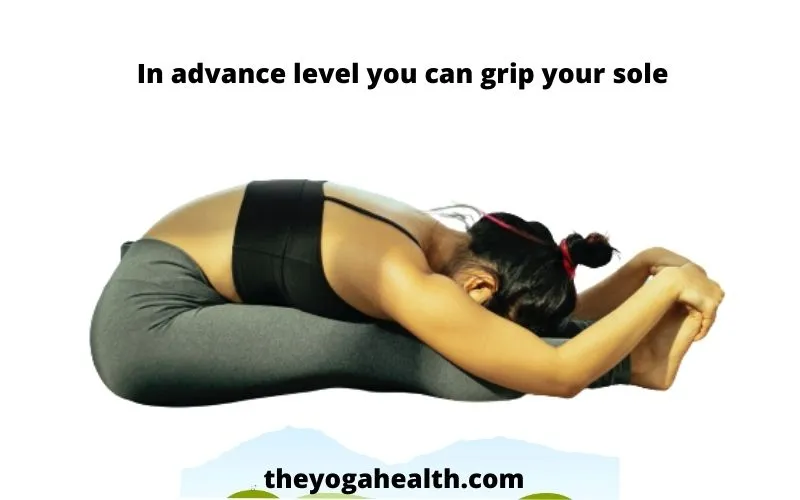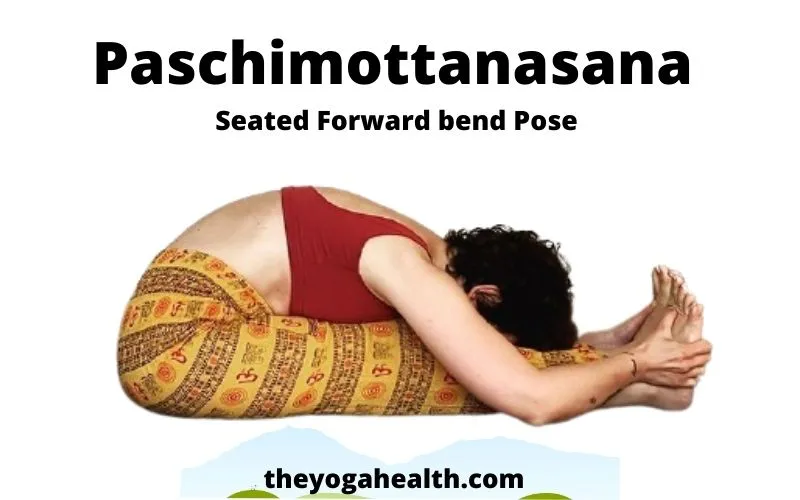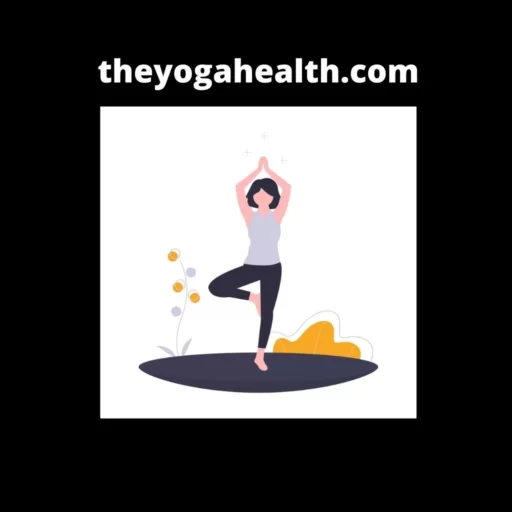Paschimottanasana (Seated Forward bend Pose) is considered one of the best among all asanas in the Hatha Yoga. It helps in increasing digestive fire in the body and also helps in achieving a flat stomach.
The regular practice of this asana makes the practitioner disease free and helps him to maintain ‘Brahmacharya’ in his life, that’s why this asana is also known as ‘Brahmacharyasana’.
Table of Contents
Understanding Paschimottanasana (Seated Forward Bend Pose)
‘Paschim’ in the Sanskrit language means ‘west’, it symbolizes the back of the entire body from the head to the heels. The front part of the body from the face to the toe symbolizes the east while the crown of the head is considered North and soles as south.
In this asana, the back of the entire body is stretched that’s why this asana is named Paschimottanasana.
This pose falls under the category of seated Yoga poses. In this asana, the spine is stretched to the maximum levels that tone all muscles around it.
Basic Details:
| Sanskrit Name | Paschimottanasana |
| Other Sanskrit Name | Brahmacharyasana |
| English Name | Seated forward bend pose |
| Difficulty Level | Beginner |
| Position | Sitting |
Paschimottanasana benefits following muscles:
- Upper Back
- Lower Back
- Hips
- Neck
- Hamstrings
- Abdomen
According to Hatha Yoga texts the human body comprises 72,000 nadis (channels through which prana flows) among these nadis the Ida, Pingala and Sushmna are the main nadis. Sushmna Nadi is the central channel through which the energy flows from the spine to the Sukshma Sharira (subtle body).
When this asana is performed it stretches the entire spine and stimulates the central nervous system, which helps in balancing the entire energy flow in the body.
Benefits of Paschimottanasana
This asana, offers a wide range of benefits for the body and mind. Let’s explore each point in detail:
1. Improved Appetite and Digestion:
This asana exerts pressure on the abdomen, which aids in improving appetite and digestion. It stimulates the digestive organs, including the stomach, intestines, and liver, promoting better functioning.
2. Reduction of Obesity:
Regular practice of this asana can be helpful in reducing obesity. This forward fold posture engages the abdominal muscles and stretches the entire back of the body, contributing to weight management.
3. Stimulation of Abdominal Organs:
It stimulates various organs within the abdomen, such as the kidneys, liver, uterus, and ovaries. The gentle compression and stretching motions create a beneficial effect, enhancing the strength and vitality of these organs.
4. Improved Blood Circulation and Spinal Cord Toning:
By folding forward and stretching the back, this asana enhances blood circulation in the back region of the body. It also helps tone and energize the entire spinal cord, promoting a healthier back and improved posture.
5. Relief from Stress, Depression, and Anxiety:
This asana has a calming effect on the mind and nervous system. Practicing this asana can help alleviate stress, reduce symptoms of depression, and ease anxiety, allowing for a sense of inner peace and relaxation.
6. Alleviation of Menstrual Cramps:
Women who experience menstrual cramps can find relief through the regular practice of this asana. The gentle stretching and relaxation of the abdominal muscles help soothe menstrual discomfort and promote overall well-being during the menstrual cycle.
7. Supportive in High Blood Pressure and Sinusitis:
This asana can be beneficial for individuals dealing with high blood pressure and sinusitis. The forward folding motion calms the nervous system, lowers blood pressure, and stimulates the sinuses, promoting sinus drainage and reducing congestion.
8. Improved Alignment of the Vertebral Column:
Regular practice of this asana helps improve the alignment of the vertebral column. It stretches and strengthens the muscles along the spine, allowing for better posture and spinal health.
9. Increased Vitality and Impotency Relief:
This asana boosts overall vitality and energy levels in the body. Additionally, it is believed to help address impotency concerns.
10. Better Control Over Sexual Appetite:
This asana is also known as ‘Brahmacharyasana’, that means having control over physical desires including sexual desires. The increased circulation, stimulation of the pelvic region, and the associated control over sexual appetite contribute to the potential benefits for sexual health and vitality.
Remember, it’s essential to approach this asana with mindfulness and respect for your body’s limits.
Paschimottanasana Steps:
- Sit on the Yoga mat on the floor and stretch your legs in front of you. Keep your palms on the floor by the side of your hips and take a few breaths.
- Now extent your hands and catch your toes. Hold the right big toe with the right thumb, index, and middle fingers and likewise hold the left big toe with the left thumb, index, and middle fingers.
- Now extent the spine and try to keep the back curved in. When you start the back will be like a hump. Learn to bend your back from the pelvic region and also extend your arms from the shoulders. The hump will disappear then and the back will become flat. Take a few breaths in this position.
- Now breathe out, bend and widen your elbows, pull your torso forward and try to touch your forehead onto your knees. Now little by little rest the elbows on the floor.
- Breath in and raise your head from the knees and relax.
advance Steps:
As you become comfortable in the pose described above you can take some more steps to challenge yourself.

- In the position described above you can grip your full sole and rest your chin on the knees.
- When it also becomes easy then you can clasp your hands over your feet by interlocking your fingers and rest your chin beyond the knees.
- When the above position also becomes easier then you can grip your left palm with your right hand or you can do it the other way around by gripping your right palm with your left hand.
- The advanced practitioners can even extend their hands on the floor and join the thumbs beyond the outstretched feet while keeping their chin resting beyond the knees.

You can stay in whichever above positions you are comfortable to perform, for about 1 to 5 minutes.
Precautions and Contraindications
- In the beginning it is difficult to bend fully in this asana. You don’t have to force yourself into this asana. Do it as much as possible without the pain, with practice one day you will be able to perform even the advanced steps.
- The asana should be performed empty stomach as in this asana stomach is compressed fully into the thighs.
- Keep your knees aligned and don’t allow them to turn out. If knees are turned out it will lessen the stretch of your hamstrings and puts the stress closer to your joints.
- Don’t bend your back at the beginning of the asana, keep your back straight as far as possible, then turn and see that your belly fully presses into your thighs.
- Pregnant women should avoid this asana.
- Avoid doing this asana if you have any injury on the arms, shoulders, hips, or ankles.
- If you have undergone any operation or surgery this asana should be avoided till you fully recover from it.
- To realize the full benefits of the asana keep the back of the legs at the knees joint and thighs fully grounded to the floor because in the initial stages the legs are likely to be lifted off the floor.
- People suffering from the slipped disk should avoid this asana because this asana puts a lot of pressure on the lower back which can further aggravate the situation.
- People suffering from hernia should also avoid this asana because when internal organs are pressed when the body moves forward it puts lots of pressure on them and it may further cause injury to the abdominal wall or intestine.
Conclusion For Paschimottanasana:
Paschimottanasana (Seated Forward Bend) tones the abdominal organs and gives them strength, it also keeps them free from lethargy. This asana also tones kidneys, liver, and other organs of the stomach and rejuvenates the whole spine.
FAQ: Paschimottanasana (Seated Forward Bend)
Q1. Can Paschimottanasana increase height?
Ans: This asana is one of the asanas that is recommended for increasing height because in this asana the whole spine is stretched and stimulated that increases flexibility in the body and all organs work to their full capacity.
Q2. Is Paschimottanasana helpful in weight loss?
Ans: Yes! the regular practice of this asana will not only help in reducing weight but will also improve digestion.
This asana puts a lot of pressure on the organs of the stomach, which makes their function efficiently.
Q3. How Paschimottanasana cures impotency?
Ans: This asana is also known as ‘Bramachryasana’, ‘Brahmacharya’ means ‘celibacy’ in the English language.
This asana increases strength and vitality in the body and helps to cure impotency.
The regular practice of this asana also leads to better sex control over the sexual appetite.
Do share your experience of doing this asana, it will definitely help other readers as well and if You have any question or comments regarding this Pose, you can mention so in the comments section below.





